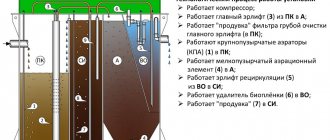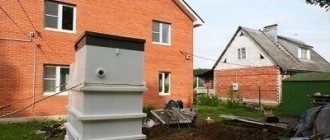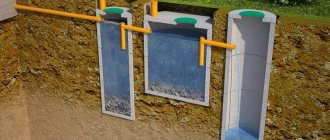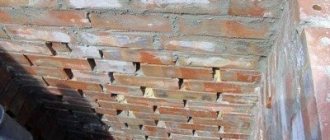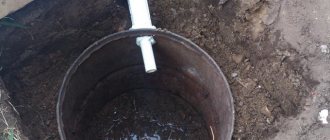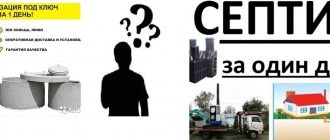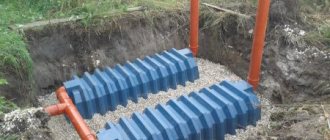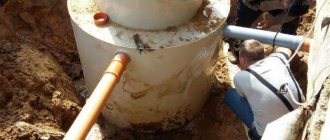The BioDeka autonomous sewer system effectively cleans household wastewater from harmful microorganisms and food particles, eliminating unpleasant odors. Installation of the station takes 2–3 hours. The operating principle of the BioDeka 5 septic tank is based on the characteristics of the life activity of aerobic bacteria. The water obtained as a result of purification can be used for:
- glaze;
- car washing;
- and other technical needs.
The performance of a septic tank does not depend on the volume of wastewater at different times of the day. The main advantages of the system are:
- environmental safety;
- no unpleasant odor;
- durability of the structure;
- competitive cost;
- resistance of the polymer tank to aggressive environments.
Proper operation of a septic tank requires the presence of a stable source of electricity, so for areas with frequent and prolonged interruptions in the supply of electricity, you will have to buy a generator or install an autonomous sewage system such as a bioseptic tank.
Types of popular septic tanks Deka
The manufacturer produces several models of septic tanks, taking into account the number of water users in the house. The numbers indicated in the marking, for example 3, 5, 8 and 10, mean that this is the number of users the tank is designed for.
Among the most popular models are the following:
- BioDeca-3 S-600. A budget model designed for a family of 3 people, even if they use the sewer system at the same time. The small dimensions of the unit facilitate installation. Sewage pipes enter the tank at a depth of 60 cm, so for regions with cold winters, thermal insulation of communications is necessary.
- BioDeca-5 P-1300. The principle of operation of the Deca 5 septic tank is no different, but in comparison with the previous model, the tank is designed for a larger number of users. Other differences: greater height, and sewer pipes are buried 130 cm. The system can be installed in any region of the Russian Federation, regardless of the level of soil freezing. There is no need to insulate communications. Marking with the letters “S” and “P” means gravity or forced movement of wastewater. Forced drainage is chosen for areas where groundwater is high.
- BioDeka-8 P-1800. The system is designed for 8 users, so it can serve 2 neighboring houses with up to four residents in each. The overall design with a 180 cm deepening of sewer pipes is suitable for use in regions with frosty winters.
Installations designed for 20 users are suitable for gas stations, public buildings, mini-hotels, cafes.
Where and why is the autonomous sewage system “Biodeka” installed?
Biodeka is a single-mode station that produces deep biological treatment of domestic wastewater in permanent residences.
These structures are produced in Russia, therefore they are domestic and, accordingly, adapted to a wide variety of climatic conditions.
It is worth saying that the autonomous “Biodek”, regardless of its performance, is capable of recycling wastewater from the entire house, that is, from the kitchen, toilet, and ending with the washing machine and dishwasher.
Today, a variety of septic tank models have been created, allowing you to choose the best option, both for one house and for an entire country cottage, or a station for an apartment building or an entire village.
The septic tank is additionally equipped with a drainage pump and a built-in container. In addition, the system is equipped with an emergency sewer system, which will indicate the presence of a breakdown or overflow of water.
The device of the BioDeka complex
BioDeka 5 septic tank: step-by-step principle of operation
The general operating principle of the BioDeka 5 septic tank comes down to the following sequence of steps:
- Wastewater flows by gravity into the receiving chamber.
- Thanks to the large-bubble aeration element, liquid waste is mixed, as a result of which large fractions are crushed and debris is cut off by a filter.
- The waste mixture flows through the airlift into the aeration tank chamber.
- The fine-bubble aeration element saturates the liquid with oxygen, resulting in its oxidation and nitrification.
- The liquid moves by gravity to a secondary settling tank, where denitrification and separation of sludge from purified water occurs.
- Sludge from the bottom of the secondary settling tank is pumped by airlift into the stabilizer.
- Part of the working sludge with bacteria moves from the stabilizer to the receiving chamber.
- The film floating in the secondary settling tank is sucked in and broken up by a degasser.
- The purified liquid from the upper part of the secondary settling tank is sent for discharge.
Cleaning device and principle
The body of the installation is made of high-strength plastic and is internally divided by partitions into several chambers. Each chamber is responsible for a specific cleaning stage. The main design details include:
- receiving chamber;
- aeration tank;
- stabilizer;
- secondary settling tank;
- aerator;
- airlift.
The station uses the most effective cleaning method today - aerobic biological treatment. This method involves purifying water with the help of microorganisms that require oxygen and organic matter to maintain life.
Video: Autonomous sewage system BioDeka 5 P-800 (installation, description of the operating principle of the treatment station)
The cleansing process takes place in several stages:
- gravitational separation of insoluble and heavy particles – primary sedimentation;
- biological purification;
- secondary settling – settling of activated sludge.
After the wastewater enters the primary settling tank, the liquid is freed from heavy and insoluble fractions. Then the settled water, through airlifts, enters the chamber where aerobic bacteria come into action and biological treatment begins.
After which, the resulting sludge flakes are separated from the liquid by settling to the bottom of the settling tank. The output from the septic tank is well-purified water, which can be used as technical water, for watering plants, etc.
Septic tank BioDeka 5: operating principle of system elements
But in order to understand how Bio Deca 5 septic tanks work correctly, it is worth taking a closer look at how systems of this type are designed. The cleaning station is equipped with a compressor that constantly pumps air into airlifts, bubble aerators, a degasser and a filter for coarse fractions. When the level of wastewater in the receiving chamber increases, according to the laws of physics, the main airlift works faster. At the same time, the recirculation airlift pumps liquid at a constant level in the secondary settling tank and aeration tank. The level is maintained by overflow, and excess water is discharged outside the system.
Considering that the drainage pump chamber is mounted above the water level in the receiving chamber, as the productivity of the main airlift increases, it does not change in the recirculation one. An equilibrium position is provided, under which both airlifts operate at the same speed and the station moves the wastewater in a circle, cycling. The system is simple but effective. All processes provided by the cleaning technology are divided not by time, but by chambers without the need to switch modes. And the biggest plus is that the system does not have a solenoid valve!
Technological process of the installation.
BioDeka installation has a single-mode operating principle. The inlet pipe enters the receiving chamber ( PC ). The insertion of the supply pipe must not be lower than the maximum (critical) mark indicated for a particular model in its name. It is recommended to insert as high as possible the critical level, this will allow for the largest volley discharge into the installation and emptying of the supply pipe itself. The outlet of the outlet pipe, gravity ( Ø110 mm ) or forced ( Ø25 mm ), is carried out from the secondary settling tank ( SS ). In units marked C (gravity flow), the outlet is already installed at the factory. If the name contains the letter P (forced), the exit is carried out during installation.
Installation and launch of the Deca septic tank
Before proceeding with the installation of the structure, you should clarify how the BioDeka 5 septic tank works correctly and what requirements apply to the installation. To avoid mistakes, it is recommended to entrust installation to specialists.
The sequence of stages for installing a septic tank is as follows:
- Selecting a location taking into account SanPiN requirements.
- Excavation work (digging a pit).
- Installation of a septic tank in a pit.
- Laying communications (pipes) to the house and to the place where purified water is discharged.
- Filling the reservoir with liquid, backfilling with soil around it.
- Equipment startup.
If necessary, sewer pipes are insulated. The service life of different models varies, but on average the system is designed to last 50 years.
Advantages and disadvantages
Before purchasing any product, it is worth finding out about its existing advantages and disadvantages. This also applies to septic tanks, because each of them has its own specific pros and cons.
Advantages
First, let's take a look at the advantages of septic tanks of this brand:
- wastewater treatment by 98%;
- environmental Safety;
- absence of unpleasant odors;
- simple and reliable design;
- practically does not clog;
- high strength – cylindrical body with one technological seam;
- relatively light weight;
- long service life;
- affordable price.
Flaws
The main disadvantage of the Biodeka septic tank, as well as other VOCs, is its dependence on electricity. If there is a power outage, the station simply will not work, so at this time it is better to reduce the use of water, otherwise there is a high risk of flooding the septic tank.
You may be interested in information on other septic tanks:
Decepticon
Topas 5
Unilos
Rules for installing a septic tank
Using toilet paper for septic tanks
Operating instructions for owners of the Deca septic tank
The operating principle of the BioDeka 5 septic tank provides for an autonomous mode, but control by the owners is still needed. Visual inspection is carried out once a month. The tank can be installed in any soil, since the body is sealed and can withstand frost. It is allowed to install a storm sewer or drainage system to drain purified water from the septic tank.
In order for the equipment to serve for a long time and without breakdowns, it is necessary to follow the rules specified by the manufacturer in the operating instructions. General recommendations:
- It is prohibited to throw into the sewerage materials that do not decompose (solid waste, fabrics);
- it is necessary to prevent the entry into the drain of substances that are potentially dangerous for bacteria that process wastewater (chlorine, petroleum products, various alkalis and acids);
- It is necessary to carry out timely maintenance when disposing of activated sludge.
Autonomous sewerage maintenance involves the following work:
- Visual inspection for timely detection of damage.
- Checking the outlet effluent for the presence of foreign impurities and unpleasant odors.
- Estimating the amount of activated sludge, pumping out the excess at least once a year.
- Maintenance of airlifts and filters once every six months.
How to force a gravity installation ↑
All Biodek models in the factory version are gravity-fed, but each of them provides the possibility of conversion into a forced one. The retrofit kit is sold together with the case; you can attach it yourself or with the help of specialists.
The kit includes the following parts:
- outlet hose;
- liquid reservoir;
- submersible pump;
- set of fittings.
Detailed instructions for fixing the container and inserting the hose are included with the equipment. If you have questions about installation, you can always seek advice from the company’s specialists from the technical support service.
Layout diagram: main components
To learn more about how the BioDeka 5 septic tank functions (operating principle, cleaning sequence, bacterial needs), it is worth studying the system design diagram.
The equipment is housed in a durable cylindrical plastic case. The single seam on the tank increases the strength and reliability of the container. Inside there is a system of chambers separated by partitions to ensure sufficient rigidity. Each camera has its own purpose. The entire system is quite compact and does not require human intervention.
Main components of the septic tank:
- primary settling tank where wastewater goes;
- an aeration tank chamber where the liquid is saturated with oxygen;
- stabilizing compartment;
- denitrification area;
- secondary settling tank;
- airlifts and aerator.
In addition to the above, the septic tank provides an emergency notification of an overfilled tank and a malfunction of the system.
Description of Biodeka station
Deep biological treatment plant “ BioDeka” is a local treatment facility designed to treat domestic and similar wastewater directly at the places of their origin using deep biological treatment without the use of consumable chemical and biological components.
The cleaning technology and the main built-in systems of this installation are subject to patent law. The design capacity of the BioDeka installations of the entire model range takes into account water removal from one consumer in the amount of 200 liters of wastewater per day, 60 g BOD₅/person per day (BOD₅ - biochemical oxygen demand - equivalent to the amount of organic pollutants), which is close to or equal to urban conditions residence.
Installations of the BioDeka model range are designed and manufactured by DEKA LLC in accordance with TU 4859-002-89149203-2014 and meet the requirements of GOST R IEC 60204-1-2007 and GOST 12.2.003-91.
The units are produced in various designs, differing in daily productivity and insertion depth of the supply sewer pipe.
The body material is a homogeneous and integrally foamed copolymer of polypropylene and ethylene, with an operating temperature from +40˚С to -40˚С.
The body design is a self-supporting cylindrical vessel with partitions, intended for underground installation, with a rectangular neck and an insulated lid. The color of the neck and cover of the unit is green.
Treatment technology – biological treatment with suspended activated sludge.
Aeration system – membrane tubular polymer aerator.
The floating biofilm removal system is a method of degassing the biofilm of a secondary settling tank by pumping out the upper layers of the secondary settling tank and bubbling them in a biofilm remover to remove floating gases.
The method for removing nitrogen compounds is the biological method of nitro-denitrification together with general biological treatment.
The alarm system is a light alarm mounted on the cover of the unit.
Forced drainage system (optional) – built-in storage tank with drainage pump.
Disinfection system (optional) – built-in UFO (ultraviolet disinfection) system. Units of the BioDeka model range, from model BD-5 to model BD-20 inclusive, are manufactured in a single, cylindrical housing.
Complete set of BioDeka installations:
- Installation housing – 1 pc.;
- Compressor – 1-2 pcs. (depending on model);
- Technical passport – 1 pc.;
- Sewer outlet PP 110x15° (gray) – 1 pc.;
- Welding rod PP 7 mm, 0.5 m – 1 piece;
- Alarm system:
- Waterproof lamp – 1 pc.;
- E27 incandescent light bulb – 1 pc.;
- Float switch (assembled) – 1 pc.;
- Corrugated pipe, L=2 m – 1 pc.;
- PVA wire 3x1.5, L=2 m – 1 pc.;
- Supports (clips) Ø20 mm – 6 pcs.;
- Screw 3.5x16 – 6 pcs.
How to maintain a BioDeka septic tank yourself
To carry out maintenance for a Biodeka septic tank yourself, you need to know what procedures the process consists of and their frequency. The main points include:
- Sludge pumping . How often it is carried out depends directly on the regularity of use of the local sewerage system.
To check if pumping is necessary, scoop some liquid from the reservoir with a quart jar. If after 30 minutes of settling, 70% of its volume is sludge, and the rest is filled with water, it is necessary to carry out cleaning
You are getting:
- Free shipping
- Installation in 1 day
- 2 year warranty
Order by phone: 8
Telephone To pump out, you should use a service airlift. It is connected to the manifold using plastic nozzles. After the procedure, the Biodeka septic tank stabilizer must be filled with clean water. The sludge can later be useful as a biofertilizer for non-fertile plants.
- Cleaning tank walls . This is done using a high pressure washer. A regular Kärcher will do.
Cleaning the walls of septic tanks. Helps avoid unnecessary layers within the system
- Cleaning the compressor filter . Maintenance of the Biodeka septic tank must necessarily include this point. The filter is located directly under the top cover of the device, so you just need to remove it, shake it off and rinse with warm water. Then, set it to its original position.
- Cleaning cameras from debris . Be sure to remove any accumulated waste solids. This could be leftover food, packaging, or other items that could potentially clog the cleaning system.
Avoid blockages when operating private sewer systems
Maintenance "Biodek", a video about which is presented below, will help you learn in more detail about cleaning a septic tank with your own hands.
"Biodeka" service: video. How to properly clean a septic tank
Installation of BioDeka installations
Attention!!!
Installers who have been trained at the company's office and have permission to carry out installation work are allowed to carry out installation work. In case of installation
and by persons who have not undergone computer training
If this occurs, the warranty may be void.
So, how does the installation of BIODEK go?
What is more profitable to buy, Eurolos BIO or BioDeca - price comparison
| Septic tank model | Price, rub.) |
| "Eurolos BIO"3 | 69 350 |
| "BioDeca" 3 | 78 100 |
| "Eurolos BIO"5 | 77 600 |
| "BioDeca" 5 | 83 600 |
| "Eurolos BIO"8 | 100 700 |
| "BioDeca" 8 | 107 300 |
*Prices are current at the time of writing the review. You can view current prices on our website.
As we can see from the table, the products are noticeably cheaper, which is an undeniable advantage in their favor. I would also like to note that the price comparison included models with forced drainage, which are somewhat more expensive. If we consider gravity-fed devices, the price gain will average an additional 5,000 rubles per model, which further increases the cost gap. Definitely, the point in this category goes to Eurolos products.
Why is BIODEKA better?
These new generation autonomous sewers are distinguished by the ratio of quality and price - and it cannot but catch the eye of the most inexperienced person in this area. However, there are many more qualities that make BIODECA an enviable offer on the autonomous sewage market in our country.
If we talk about technical innovations, there are many of them:
- Increasing the minimum diameter of the airlift pump by three times (up to 5 cm).
- Reducing the number of airlift pumps to one.
- Increased mean time between failures by four times.
- Increased reliability and control of emergency situations using a level sensor in the sump.
